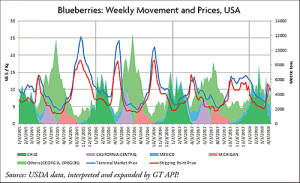As blueberry consumption continues to rise, producers around the world try to keep up with demand.
This sweet, juicy orb is convenient, kid friendly, and on trend. It also has a low glycemic index and is full of antioxidants, so it truly is the go-to fruit of the health industry.

A BRIEF HISTORY
Blueberries were gathered by Native Americans for centuries, long before colonists arrived from Europe. The blueberries were eaten fresh, dried for later use, and revered for their medicinal properties.
Indians then taught colonists about native plants, including wild blueberries that grew from low bushes. The type most cultivated today is a highbush variety domesticated in the early twentieth century by Elizabeth White and Dr. Frederick Coville. Wild blueberries, or lowbush varieties, are still part of the market and are harvested from July to September.
These smaller berries have variations in coloring, higher antioxidant levels, and are popular with agritourism and u-pick operations. Lowbush blueberry production fell in 2017, but the berries do compete with highbush varieties and often have a higher price during peak production.
In 2015, wild blueberry prices were 51 percent higher than highbush varieties. In 2016 they were 64 percent higher, and in 2017 they were 68 percent higher (due to a contraction in supply because of cold weather).


